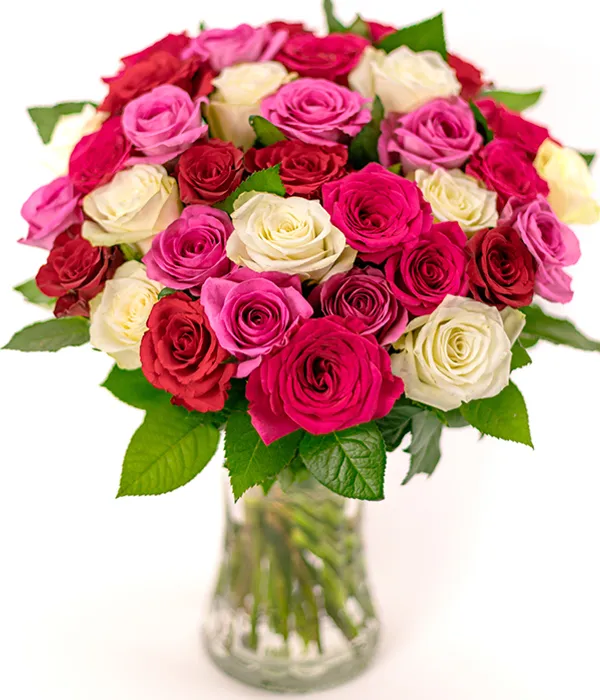How to preserve a rose
Roses are the classic symbol of love, beauty, and emotion. They hold memories and feelings, but they don't last forever.
Or do they? Preserving a rose as a keepsake is actually more than possible, and represents a timeless way to capture a moment and the beauty of a rose for a long time.
In this article, we'll explore the simple methods to help you preserve a rose as a cherished memory, keeping its charm and sentimental value alive.
Related Pages: Romantic Card Messages, Valentines Day Flowers, Happy Birthday Messages
How do I preserve roses for keepsake?
-
Choose your roses: Select roses that are at their peak of their freshness, just before they fully open. This is when they have the most vibrant colours and are least likely to wilt during drying.
-
Prepare roses: Take your time to trim away any extra leaves, pesky thorns, or petals that have seen better days. This helps the drying process go smoothly and keeps your roses looking pristine.
-
Tie roses together: Group the roses into small bundles (usually three to five roses per bundle) and tie them together with string or twist ties. Ensure they are tightly secured so they won't slip down.
-
Hang roses upside down: Hang the bundles of roses upside down in a dark, dry, and well-ventilated room. This can be a cupboard, attic, or any place where they won't be exposed to direct sunlight. Doing this allows the roses to maintain their shape and prevents wilting.
-
Be patient: Let the roses air dry for around two to four weeks — the drying time can vary depending on the humidity and conditions of your drying area.
-
Enjoy: After drying, carefully remove the strings or twist ties. Your dried roses are now ready to use for crafts, arrangements, or other decorative purposes.
Choosing the right roses
Getting the right roses is a key factor in how your dried flowers turn out. Look for ones that are in that "almost there" stage – not fully bloomed, but showing off their colours nicely. These are the roses that will hold up best when you dry them.
As for colour, darker roses tend to keep their hues better than lighter ones when dried. Among these, hybrid tea roses stand out. These typically have long, slender stalks with one large, high-centred flower per stem, making them a favourite choice for cut flowers and floral arrangements.
Drying rose heads (whole roses)
Here's the lowdown on drying complete rose blossoms — everything from the petals to the bud in the centre.
What can you do with dried whole roses?
Dried whole roses serve both decorative and practical purposes. They frequently make charming appearances at weddings, whether used as decorations, nestled in bridal bouquets, or as centrepieces, adding a touch of romance to these special moments.
While, if you're into DIY and crafting, dried rose heads are a perfect choice, and you can turn them into wreaths, garlands, or beautiful floral arrangements. They're also great for more casual crafts like homemade greeting cards, scrapbooking, and creative shadow boxes.
How long do dried roses last?
Dried roses can retain their shape, colour, and beauty for several years. Over time, they may become more fragile, but with gentle handling and protection from dust and moisture, they can serve as a keepsake for a long time.
How do you dry roses to keep them forever?
Forever is a pretty long time, but using silica gel to dry roses is a great way to keep their beauty intact for years to come. Here’s how to do it:
- Prune: Begin by pruning your roses as you would for normal air drying.
- Prepare gel: Take a shallow, airtight container and add a layer of silica gel (a desiccant that removes moisture) about one to two inches deep.
- Cover: Gently bury the roses in the gel, ensuring they are evenly spaced and not touching each other, before carefully pouring more silica gel over the roses until they are completely covered. Be sure not to press or bend the petals during this process.
- Seal: Once the roses are covered, seal the container with an airtight lid.
- Dry: Allow the roses to air dry for approximately two to four weeks.
Over this time, the gel will gradually absorb moisture from the flowers, effectively preserving them a long time.
Do dried roses still smell?
Unfortunately, roses lose their original fragrance during the drying process. But if you want your keepsake to have a scent of its own, you can always add a few drops of essential oil to the dried flowers. Rose-scented roses, anyone?
Drying rose petals
Drying rose petals instead of rose heads has some differences in the process and uses. Here's what you need to know:
What can you do with dry rose petals?
There are many delightful ways to make the most of dry rose petals. You can toss them into the bath for a relaxing soak, mix them up with some dried herbs, flowers, spices, and essential oils to make some potpourri, or even sprinkle edible rose petals into your cooking and baking.
How do you dry rose petals naturally?
- Harvest the rose petals: Choose roses that are almost fully bloomed but not overripe. Gently pluck the petals from the roses, making sure to remove any damaged or discoloured petals.
- Spread the petals: Spread the rose petals in a single layer on greaseproof paper on a tray. This will allow for good air circulation.
- Let them dry naturally: Place the tray with the rose petals in a cool, dark, and dry room. Avoid direct sunlight, as it can cause the petals to lose their colour.
- Check and turn them: Check the petals daily and gently turn them over to ensure even drying. This helps prevent mould or moisture from accumulating.
- Store: Once the rose petals are completely dry, store them in an airtight container or a resealable bag. Keep them in a cool, dark place away from moisture and sunlight to maintain their fragrance and colour.
Some roses are easier to preserve than others. Learn more about the different rose types in our comprehensive article, and don't hesitate to reach out to us for additional information on our floral selections and delivery choices.







